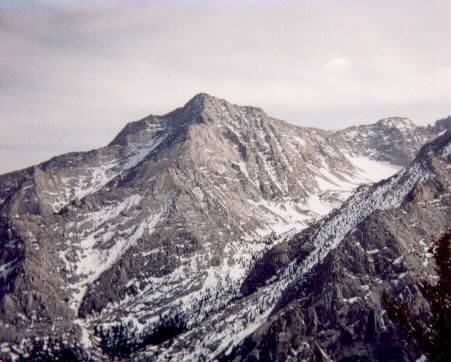
Lone Pine Peak 12,944'

The north (left side) and west (right side) faces of Lone Pine Peak as seen from the Whitney Portal North Wall Summit Ridge.
Lone Pine Peak from the southeast. To the left is Mt. LeConte 13,960'
Summit Views: To the north is Mt. Williamson 14,375' in the upper left. In the top center is the Sierra Crestline as it heads north to Taboose Pass, Split Mt., and the Palisades. In the lower right quadrant is the Whitney Portal North Wall.
To the SE is the town of Lone Pine and the Alabama Hills. On the right is Owens Lake which was drying up with the retreat of the ice age and got the final chop when the city of Los Angeles came to the Owens Valley and bought up all the water rights. Four million tons per year of alkali dust being blown from the lake each year has at least caused the area groundwater to be pumped into the lake but a return to the 100 square mile, 30' deep, lake that existed before the Los Angeles Aqueduct seems unlikely.
The north face of Mt. Langley 14,042'.
Left to right is Mt. LeConte
13,960' , Mt. Mallory 13,850', and Mt. Irvine 13,770'. These mountains may
appear as bumps in the ridgeline to those that haven't made the effort to get
up them and perhaps they are.
Some mountains are more mountainous than others. This can be called a
mountain's "Power" which is calculated by multiplying the distance
from the summit to the low point between the next mountain times the distance
to the next mountain.
Mt. Everest at 8848 meters and the South Col is 7986. 8848 minus 7986 = 862
meters. Distance from Mt. Everest to Mt Lhotse= 4 km. 862x4000=3,448,000 power.
This is dwarfed by Mt. Shasta rising 3km above the forest around it and is
50(?)km to the nearest mountain, Mt. Lassen. 3000x50,000= 150,000,000 power.
Few would say that Mt. Shasta is more of a mountain than Mt. Everest but
nevertheless at a certain point mountains do become only bumps in ridges.
Gerry Roach, author of "Colorado Fourteeners" covers this subject in
more detail for those interested.
In the foreground of this photo is the loose rock stack comprising the summit
of Lone Pine Peak. While hiking and camping and climbing on the west face of
Lone Pine Peak I heard the sound of naturally occurring rockfall several times
every day. The Canadian Rockies are famous for loose rock but the Sierras are
loose enough. User beware.
Sunrise on Lone Pine Peak as seen from the Tuttle Creek Trailhead.
Lone Pine Peak socked in down to the valley floor. My first attempt on Lone Pine Peak via the SE route failed due to postholing in snow. The second attempt via the SE route, in spring, failed due to a storm that moved in and fortunately I decided to retreat before the mountain was socked in. Downclimbing a mountain in a whiteout or fogbank has disadvantages and staying up on the mountain until the weather clears is also not something one looks forward to.
The class 2 gully route on the west side of Lone Pine Peak. RJ Secor, author of "High Sierra Peaks Passes and Trails" is a chronic sandbagger. I would give this route a class 3. It is vertical enough and doing the first few hundred feet in crampons increases fall potential.
Self timer on the summit plateau. In the background is left to right, Mt. Irvine 13,770', . Mt. Whitney 14,494', and Mt. Russell 14,086'.